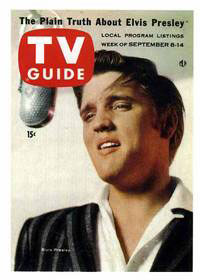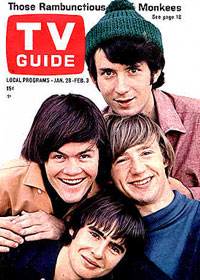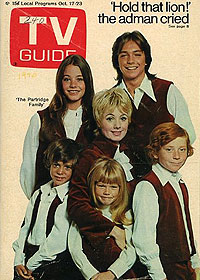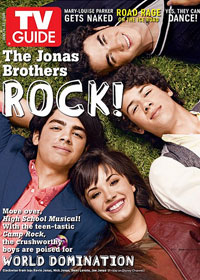A Manufactured Image With No Philosophies: The Rock Band Sitcom
Published on July 30th, 2011 in: Issues, Music, My Dream Is On The Screen, TV |By Cait Brennan

It’s no coincidence that television and rock and roll came of age together. Starting in the American ’50s, a demographic tsunami of young people eager to embrace new technologies and new sounds launched one hell of a cultural transformation. Postwar advances in affordable electronics put television’s sitcoms in every home. Cultural cross-pollination put rock and roll records into the hands of eager teen listeners. When that revolutionary new sound met that unprecedented distribution medium, it’s only natural that those two great tastes ended up tasting great together.
Elvis’s records made him an overnight sensation, but his early TV appearances broke through to the national consciousness in a way no record could: Television made the pompadour, the hip swivel, the lip curl, and the 10,000 watt personality larger than life, and Presley reached television audiences in towns and cities he could never hope to visit personally. TV, it seemed, could mint a pop star almost overnight. And that’s exactly what happened in 1957, when Ricky Nelson, the youngest son of Ozzie and Harriet Nelson, first sang “I’m Walkin'” on the sitcom The Adventures of Ozzie and Harriet. The record became a Top Five hit, and fueled by weekly TV exposure Nelson became a major star. For a time, Nelson outpaced Presley in sales, and the savvy Ozzie Nelson edited Ricky’s performance footage together to craft early “music videos.” While Ricky’s exploits were a relatively small part of Ozzie and Harriet‘s long history, the rock and roll sitcom’s roots are right here.

From Nelson’s success forward, any television show that had a credible teenager under contract was likely to try and mint a pop star: 77 Sunset Strip managed to get a hit out of Edd “Kookie” Byrnes, and the tangentially-related Hawaiian Eye got an album and hit singles out of its ingenue, Connie Stevens. But perhaps the first TV teen queen was Patty Duke, the engaging star of her eponymous 1963-66 TV series. Duke played a technically challenging (and likely exhausting) dual role, as swinging mod Patty Lane and her “identical cousin” Cathy. Her show was packed with credulity-straining but irresistibly fun guest appearances from music stars like Chad and Jeremy, Frank Sinatra Jr., Sammy Davis Jr., Bobby Vinton, Frankie Avalon, Jimmy Dean, even singer-actor Sal Mineo. It wasn’t long before Duke herself was singing on the show, and her success led to hit singles and a series of popular albums.
The rise of the Beatles, and the television public’s seemingly insatiable appetite for TV pop stars, eventually led to a watershed moment: The world’s first intentionally created multimedia rock band, The Monkees.
Inspired in part by the madcap Beatles/Richard Lester film A Hard Day’s Night, Bob Rafelson and Bert Schneider conceived a TV series that would follow the exploits of a real-life rock band. Originally, the show was to feature the Lovin’ Spoonful, but contractual issues—as well as the realization that much more money could be made from a wholly-owned band—inspired Rafelson and Schneider to hold open auditions for “4 Insane Boys Ages 17-21.” In the vibrant LA music scene of 1965, 437 “insane boys” made it to the audition round. (Charles Manson was not among them, despite persistent urban legends to the contrary.) Thus The Monkees were born.

Their music zoomed to the top of the charts—and continues to dominate oldies radio airplay 45 years later—but it was their TV series, and the way it synthesized music, comedy, and pop culture, that truly made the Monkees phenomenon special. The four Monkees—Micky Dolenz, Peter Tork, Michael Nesmith, and Davy Jones—were essentially hired on as puppets, but soon began to pull the strings themselves, wresting control of their records away from Screen Gems music director Don Kirschner and bringing their own creativity to bear on the show’s structure and content. The result is a freewheelingly subversive show that dynamited the fourth wall, openly mocked the idea of the pop star and brought everyone from Tim Buckley to Rodney Bingenheimer to Frank Zappa into unsuspecting American homes.
Irony is the most powerful force in the universe, and it’s hard at work here: We live in a time where more people have seen the Monkees’ jarring, deconstructionist movie Head than have seen the show that made them famous. Inexplicably, the TV series is still largely unavailable. Issued in two impressive deluxe DVD packages in 2003, the sets quickly fell out of print and are now tough to find—and tough to afford. For now, one of the most iconic and influential series in TV (and music) history remains relegated to some rights-holder’s vault someplace, depriving new generations of a particularly funny and ever-relevant commentary on the manufacturing of a pop culture sensation.
The Monkees aired its last first-run episode in March of 1968, but it had a long life in reruns, and it wasn’t long before another enterprising television producer took inspiration from another real-life band to create a prefab pop phenomenon. TV producer Bernard Slade took inspiration from the family band the Cowsills to create The Partridge Family, a genial sitcom about a widowed mother and her five musical offspring. The series made David Cassidy a major teen idol whose photo spreads in 16 Magazine and Tiger Beat wallpapered the walls of teenage girls (and boys) from coast to coast. Unlike the Monkees, though, there was no uprising among the cast; Cassidy and Jones did sing on the Partridge Family records, but Danny Bonaduce and Susan Dey never threatened Don Kirschner’s life for a chance to play the banjo. The Partridges issued eight albums, had smash singles and stayed on TV for four years and 96 episodes before the big Mondrian-esque bus finally rolled off the ABC schedule.

Even in the ’70s, a sitcom about a rock and roll act was not a sure thing, even with a pedigree like 1977’s A Year At The Top. The show was created by Woody Kling, former head writer of The Carol Burnett Show and later All In The Family, (but whose most indelible work for younger generations might be creating Rainbow Brite), produced by ’70s superproducers Norman Lear and Don Kirschner, and starred Paul Shaffer (then a much-in-demand star of Saturday Night Live) and teen idol Greg Evigan as two hapless musicians who have the opportunity to make it . . . to the top . . . for a year . . . if they’ll just sell their souls to a record executive who also happens to be the son of Satan. (The Faust legend got a lot of play in the 1970s.) In subsequent episodes, the guys did their best to try to help other artists avoid their fate, all while enjoying their stardom . . . with the looming threat of eternal damnation spoiling the party, of course.
Evigan and Shaffer composed much of the soundtrack themselves, and Kirschner clearly planned for the show to be a hit; Casablanca records released a quasi-soundtrack album, Greg and Paul—A Year At The Top, accompanied by a big promotional push. Alas, CBS pulled the series after just five episodes aired. Shaffer continued doing that thing he does, eventually met up with David Letterman, and became the go-to music man for the rock and roll hall of fame. Evigan, of course, later became a huge teen idol starring on B.J. and the Bear, then kept the career going with My Two Dads and later some Shatner thing called TekWar, which this writer thankfully missed.
The 1986 MTV revival of the ’60s Monkees series—and the sold-out tours, hit album reissues and the Top 20 hit it produced—inspired the powers-that-be to reboot the series. Not with its original stars, but with a whole new generation of young talent with the moxie and mullets to reach whatever a cynical ’80s marketing computer thought young people would respond to. The result, New Monkees, debuted in 1987 and eked out 13 syndicated episodes before collapsing like so much hair gel soufflé. Stylistically, the New Monkees TV show was often more of a ripoff of The Young Ones than its ’60s namesake; the guys (Jared, Dino, Marty and Larry!) were musicians who lived in some kind of baffling mansion where each door hid another zany video effect. The New Monkees sound was so much warmed-over Glass Tiger, which is more a criticism of the cloying, overcooked ’80s production choices than any particular slam at the affable young performers who, in their short television life, displayed charisma and some promising multi-instrumental skills. Alas, there are perhaps no greater ’80s fashion casualties, though their show and album faded so quickly in the pre-YouTube age that they’re barely remembered—and thus spared the ignominy of other short-lived teen idols.

After New Monkees there was a long gap in the rock and roll sitcom pantheon. Fox’s 1990 series The Heights tried to recast the idea as a drama, and while it generated a hit (“How Do You Talk To An Angel”), the show was cancelled while the song was still on the charts. In recent years, Disney Channel shows have reinvented—or at least recycled—the idea, from Hannah Montana to JONAS/Jonas L.A. to I’m In The Band, introducing the rock band sitcom to a new generation with varying levels of success.
TV rock and roll sitcoms have brought artists overnight fame, but at a cost: Somehow, an artist—especially a teen star—becomes trapped in cathode amber. Ricky Nelson became Rick Nelson, but despite adventurous forays into country and “Americana” sounds, Nelson could never shake the ghost of 1957. Patty Duke recorded six albums, had multiple Top 40 hits and sang on Shindig, Ed Sullivan, Carson , and many more, and sang on the soundtrack to her must-see movie Billie, but as she left her teen years behind, her music went with them.
But perhaps it was worst for the members of the Monkees—especially Peter Tork and Mike Nesmith, who struggled mightily to be taken seriously as the gifted songwriters and musicians they are. Dolenz and Jones—both hugely iconic talents—seem well adapted to the ridiculousness of their situation and the audience that adores them. Tork seems downright tortured at times by the television construct “Peter Tork” circa 1966 and the fans who identify with “Peter’s” plight, and with a few noteworthy exceptions Nesmith has spent most of the past 45 years pretending he never donned a wool cap at all. Those lucky young men who auditioned for the show but were rejected—said to include Paul Williams, Danny Hutton, Harry Nilsson and Stephen Stills—perhaps learned to live with the loss.
The angry ex-TV teen idol has become its own trope, with several generations of ex-pop sensations ever insistent that their true talents were obscured by all the wonderful, horrible fame and fortune they found in their youth. Rightly so, maybe, but the pernicious persistence of televised memory is especially unforgiving. Even now, Nick Jonas has moved to distance himself from his TV boy band roots, forming a new band, Nick Jonas and the Administration, featuring three decidedly adult members of Prince’s New Power Generation. One hopes Jonas will find more happiness than the TV pop stars of earlier generations, whose indelible work—perhaps a bit too indelible—will live on in repeats long after they face the biggest cancellation of all.
Time limit is exhausted. Please reload the CAPTCHA.